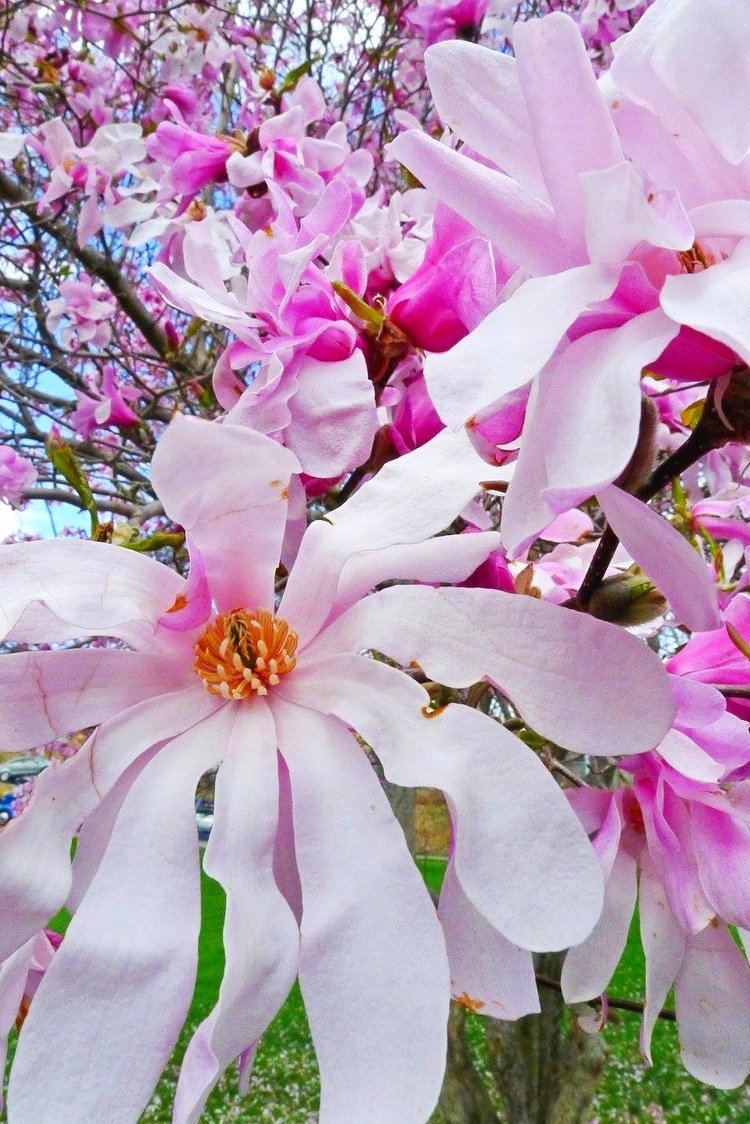Star Magnolia (Magnolia stellata)
Star Magnolia
(Magnolia stellata) “pink stardust”
A Celestial Bloom of Grace
The star magnolia (Magnolia stellata) is a breathtaking tree and a herald of spring on its way. With ethereal petals unfurling like delicate stars against a crisp blue sky, they are such magnificence! Among the earliest flowering trees to bloom, they awaken the landscape with a celestial display, bringing a sense of renewal and quiet elegance. With its pristine blossoms and graceful form, the star magnolia is a living symbol of purity, hope, and new beginnings, captivating gardeners and nature lovers alike. Among the many breathtaking varieties of star magnolia, the ‘Pink Stardust’ cultivar stands out as a truly enchanting selection. This delicate yet striking magnolia offers a soft pink twist on the classic white blooms, making it a favorite for gardeners who seek both elegance and a touch of pink and blushing romance in their landscapes.
A Dreamlike Display
‘Pink Stardust’ earns its name from the way its soft, star-shaped petals unfurl in a gentle blush hue, resembling scattered stardust at dawn. As the flowers mature, their pink tones deepen slightly, creating a subtle ombré effect that catches the light beautifully in early spring. Unlike some magnolia varieties that display bold, saturated hues, ‘Pink Stardust’ exudes a more delicate charm, bringing a sense of ethereal grace to any garden.
A Botanical Gem: Origins
Magnolias are among the most ancient flowering plants, with fossil evidence indicating their presence during the Cretaceous period, approximately 95 million years ago. This predates the emergence of bees, suggesting that early magnolias were primarily pollinated by beetles.
A distinctive feature of magnolia flowers is their structure: the floral organs are arranged spirally around a central axis, forming a cone-like shape rather than the concentric rings seen in many other flowering plants. Additionally, magnolia flowers possess undifferentiated perianth parts known as tepals, where sepals and petals are not distinct but rather fused into similar segments.
The robust nature of magnolia flowers, including their tough carpels, is believed to be an evolutionary adaptation to withstand damage from beetle pollinators.
Native to Japan, the star magnolia has long been revered for its beauty and resilience. In traditional Japanese gardens, it is planted as a symbol of peace and spiritual enlightenment, its soft, fragrant blooms offering a moment of tranquility in the fleeting early days of spring. Across cultures, magnolias are associated with dignity, perseverance, and feminine strength, their ancient lineage tracing back millions of years, making them one of the oldest flowering plants on Earth.
Much like its namesake, the star magnolia appears as a constellation of light amidst the bare branches of winter, signaling the arrival of warmth and growth. Whether planted as a solitary specimen, used in a flowering hedge, or cherished as a seasonal delight, it remains one of nature’s most elegant and timeless gifts.
In every petal, in every bloom, the star magnolia whispers of quiet beauty, endurance, and the gentle awakening of spring, a floral star shining brightly in the garden’s embrace. ✨🌸
Fragrance & Sensory Appeal
Much like its white-flowered relatives, ‘Pink Stardust’ carries an intoxicating fragrance—a blend of citrus, vanilla, and fresh spring air. This soft yet noticeable scent makes it a wonderful choice for planting near patios, walkways, or entryways, where its aroma can be fully appreciated. The petals themselves are silky and smooth, adding to the flower’s luxurious appeal.
Varieties of Star Magnolia
While the classic white-flowered Magnolia stellata remains the most well-known, several stunning cultivars have been developed to enhance its beauty:
‘Royal Star’ – A beloved variety with larger, fuller white blossoms and an intoxicating fragrance.
‘Pink Stardust’ – A delicate pink cultivar that deepens in color as the flowers mature.
‘Centennial’ – Known for its profuse blooms and robust growth habit, making it a standout in the landscape.
‘Waterlily’ – Features more elongated, gracefully arching petals, giving it a waterlily-like appearance.
Each variety adds its own charm, ensuring that there is a star magnolia suited to every garden and aesthetic preference.
Growing and Caring for Star Magnolia
The star magnolia is a low-maintenance yet rewarding tree, thriving in a variety of climates and soil conditions. To cultivate its full potential, consider the following care tips:
Sun & Soil – Prefers full sun to partial shade and thrives in well-draining, slightly acidic soil.
Watering – Requires regular watering during establishment but becomes drought-tolerant with age.
Pruning – Minimal pruning is needed; shaping can be done after flowering to maintain a graceful form.
Protection – As an early bloomer, its buds can be susceptible to late frosts, so planting in a sheltered location is beneficial.
With proper care, a star magnolia can live for decades, gracing gardens with its celestial blooms year after year.
Bibliography
Bunting, Andrew. The Plant Lover's Guide to Magnolias. Timber Press, 2016.
Callaway, Dorothy J. The World of Magnolias. Timber Press, 2005.
Gardiner, Jim. Magnolias in Art and Cultivation. Royal Botanic Gardens, 2012.
Sarker, Satyajit D., and Yuji Maruyama, eds. Magnolia: The Genus Magnolia. Routledge, 2002.
Using Magnolias for Health. Mother Earth Gardener, 2020.
https://www.handmadeapothecary.co.uk/blog/2019/3/16/magnolia-a-foraged-spice-cupboard The best write up!!! Thank you <3 <3

